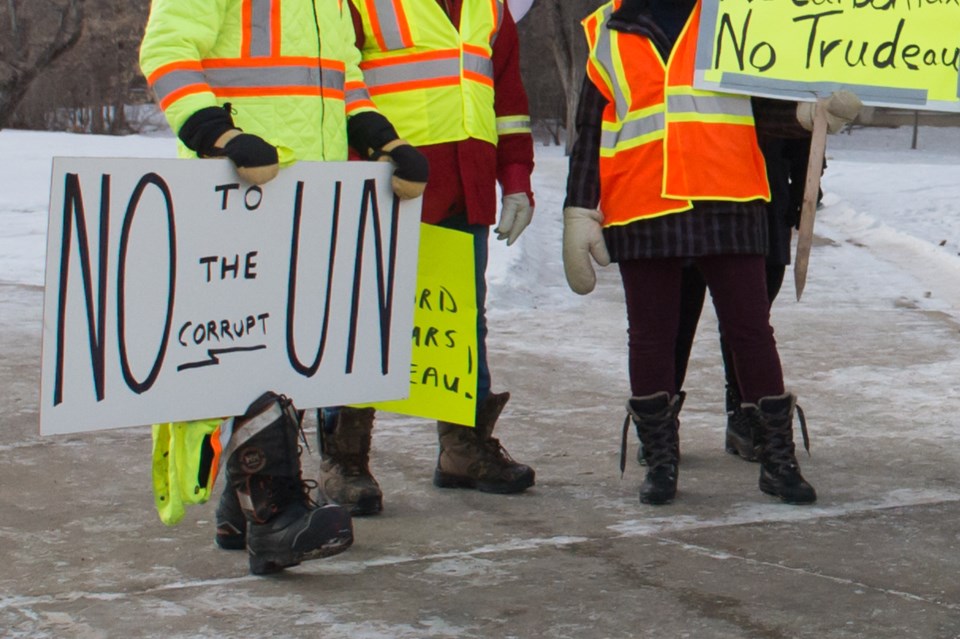When oilfield protests swept across oil country in December, there was immediately a symbol associated with them, the high visibility yellow vest.
The connection to the oil patch was immediately evident – everyone who works in the field has either a yellow high visibility vest in their truck or high visibility stripes on their coveralls.��
Around the same time France was, and still is, in an uproar against its government. In France, it is now a requirement to keep a yellow vest in your vehicle, to be worn when changing a tire or what not, as a sign of distress. They are mad at their government, so it was their sign of distress.
But France’s issues were not the Canadian oilfield’s, and the prevalence of violence at yellow vest protests in France was not something people wanted to replicate here.
Here, the yellow vest also became its own rallying point – a uniform, as it were, of those upset with the federal Liberal government. But right from the get go, there have been issues.
For most, if not all, wearing the yellow vests, key issues have been the federal government’s killing of the Northern Gateway and Energy East Pipelines, as well as their flubbing of the Trans Mountain Expansion. Then there’s the carbon tax. For many in southeast Saskatchewan, the government’s planned phase out of coal-fired power generation is huge.
But even at the earliest protests, some people started carrying signs and talking about issues that just didn’t fit with all the energy concerns. They were concerned about migrants, and many were quick to point out – illegal migrants. They were carrying signs decrying the United Nations. Some people seemed to think the United Nations is going to take over Canada, as part of some sort of “one-world government.”
And it is on these migration issues, I knew right away, the yellow vest brand would be heading to the dustbin of history.
I pointed out to many of those involved that talking energy and migration isn’t like they’re talking apples and oranges, they’re talking apples and sausages. They’re not even the same food group. And any talk about migration was going to take away from the energy message, because no matter what you say, people are going to associate this talk with racism.
I first said that on Dec. 15. I wasn’t wrong.
And from what I saw on multiple Facebook pages associated with the Yellow Vest movement, I absolutely was not wrong. I don’t know if the toxic content was 40 per cent, 10 per cent, 1 per cent or 0.1 per cent, but there was enough of it, and people cheering it on, to paint the yellow vest with a black brush. And, as I suspected would happen, other media picked up on that and ran with it.
After a flurry of protests and convoys under the yellow vest banner in December, by January, people were being expressly asked to not wear yellow vests at rallies. This first occurred in Saskatchewan at the one in early January, where Premier Scott Moe joined a number of other speakers on the steps of the Legislature in a -30 C wind chill. It happened again in Moosomin a month later, when Moe was joined by New Brunswick Premier Blaine Higgs and federal Conservative Leader Andrew Scheer at a rally in Moosomin.
Other groups in Alberta also distanced themselves from the yellow vests. Canada Action was involved in both of these prominent Saskatchewan rallies, and they cancelled their planned convoy to Ottawa because they didn’t want to be affiliated with the yellow vest.
The remaining Yellow Vest convoy to Ottawa became the United We Roll! Convoy to Ottawa. While those who chose to wear yellow vests were not told to stay home, any talk about the United Nations and migration was definitely at the periphery.
Now I am catching wind of a third wave of protests – and there is one thing that has been emphasized – NO YELLOW VESTS. There’s no equivocation on this point.
This is not rebranding. These people do not want to be associated at all with any of the negative connotations, specifically regarding immigration, that have been associated with the yellow vests. But they want their voices heard.
Why? For exactly the reason I said in mid-December. They’re not even the same food group. Energy and migration have nothing to do with each other. For those of us in the energy industry, we’re in the fight of our lives. While the United States is setting production records each month and now setting export records, we’ve been so hamstrung by the federal Liberals, we worry if our jobs and businesses can survive.
Many haven’t.
We worry because our only client for our oil may soon not need us much longer. Their production is rising so quickly, they might decide they don’t want, or need, all our oil anymore. And without Energy East, Northern Gateway and Trans Mountain, we have no way of selling out oil to anyone else. That’s what we’re worried about. Our only client has now become our biggest competitor.
When you add the ever-increasing carbon tax on everything, and the phase-out of coal, you know that this government not only does not care about our industry, but is doing all it can to hurt it. And us.
That’s why there will be a third wave of protests, and a fourth, and a fifth. But the yellow vest will fade to the background, as the real issues come to the fore.
��
Brian Zinchuk is editor of Pipeline News. He can be reached at [email protected]



